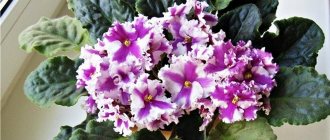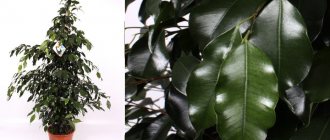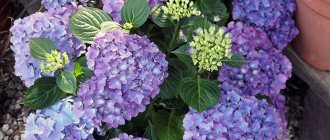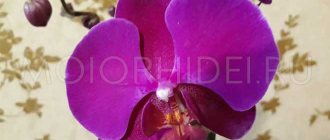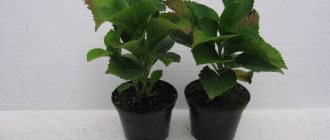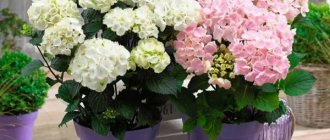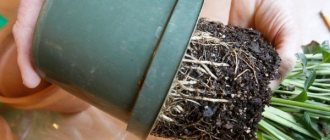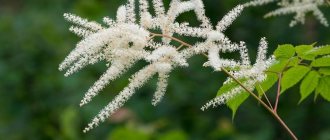Hydrangea (hydrangea) is a decorative flowering perennial of the Hydrangea family. Florists grow indoor and garden crops in the form of shrubs and trees. Indoor specimens differ in the size of the flowers.
- Optimal conditions for potted hydrangea
- Why do the tips of hydrangea leaves dry out?
Botanical description of hydrangea and its species
The plant, in the form of a compact spherical bush with pointed, large, rich green leaf blades, begins to bloom in the spring and ends in late autumn. The inflorescences have racemose and umbellate shapes with two types of flowers:
- sterile (with large petals located at the edges);
- forming seeds (small, in the central part of the inflorescence).
The shape of the inflorescences resembles large balls (up to 30 cm in diameter), which have different colors: blue, pink, cream, pale white. One bush forms up to 7 inflorescences located on the tops of the shoots, the size of which depends on their number: the more pieces, the smaller the size.
Hydrangea (hydrangea) is a decorative flowering perennial of the Hydrangeaceae family.
Experts note several interesting features of the plant:
- The color of the flowers depends on the composition of the soil . With increased acidity, blue and blue shades are obtained. Alkaline soil will result in a pink color, and neutral soil will result in a white or slightly creamy color.
- The beginning inflorescences are very delicate. One touch could kill him. Therefore, it is not recommended to remove drying flowers.
According to various sources, there are about 80 species of the hydrangea family in the world, which grow in China, Japan, America and the Far East. Not all of them are grown at home.
Flower growers breed indoor and garden hydrangeas in the form of shrubs and trees
The gardens contain shrubs, vines and trees. The most famous types include:
- Large-leaved hydrangea, growing up to 2 m, is decorative not only with large inflorescences, but also with dark green leaves with jagged edges. For cultivation in open ground in Russia, only cold-resistant varieties are cultivated. Low-growing species are selected for indoor breeding.
- Paniculate hydrangea, which is more cold-resistant and reaches a height of 50 cm. At the end of the summer, white flowers bloom on the shrub, the color of which turns into crimson and purple. After winter, it is recommended to perform formative pruning of the bush.
- Chereshkova . It has small bright green glossy foliage and flexible shoots with aerial roots, thanks to which the plant can cling to neighboring trees or building walls. There are whitish-green inflorescences along the entire stem.
- Oakleaf. A little more than 1m high. It has leaves similar to oak leaves, changing color with the onset of cold weather.
Most of the varieties are deciduous, which shed their leaves in the winter and go into a dormant state. The choice of plant type for planting depends on the characteristics of the site and the knowledge of the owner.
Choosing a landing site
The second important condition is the landing site. Large-leaved hydrangea is a light-loving crop. It grows very poorly in the shade and almost never blooms. I planted it in full sun, too, with bad results - in the heat the leaves and flowers hang like miserable rags, only in the evening they become elastic and elastic. "How so?" - you say. “After all, on the Black Sea coast they grow in full sun and do not fade!” Yes, that’s right, but let’s not forget that the air humidity there is quite high, this ensures the success of flowering. And in our conditions, sunlight up to 12 hours is optimal. At the same time, I also try to find a quiet place protected from the wind with the maximum amount of snow in winter.
Gallery: indoor hydrangea (25 photos)
Combination of hydrangea with other plants in landscape design
Hydrangea is a flower that gets along with almost all flora that can grow in the same conditions: humidity, shade and slightly acidic soil.
Good compositions are obtained in combination with low trees and shrubs, coniferous plant species.
Hydrangeas with ferns and apical pachysandra look interesting. Ivy and periwinkle are suitable for the foreground.
When decorating a garden in Japanese style, rhododendron will be an ideal neighbor for hydrangea. A beautiful environment is created from roses, lilies and clematis. Hydrangea looks no worse next to irises, primroses and daylilies.
Hydrangea will not leave any gardener or summer resident indifferent, and new varieties allow you to choose a plant with which you will definitely be able to make friends. And you won’t have to rack your brains about who the curvaceous beauty will get along with.
Hydrangea varieties for home cultivation
The most favorite type of most gardeners is large-leaved hydrangea (macrophyll), which includes a large number of varieties. The most popular varieties are those with pink flowers:
- Hamburg;
- Goliath;
- Europe.
Also read: How to preserve indoor flowers during a long vacation or absence. 5 proven methods.
Based on large-leaved hydrangea, breeders have created many varieties with different colors, even changing from one color to another. In addition to pink ones, the most common are varieties with blue and white flowers:
- Sister Teresa;
- With classic white flowers;
- Prima;
- Goliath with white and blue flowers;
- Compact.
For indoor cultivation, low-growing varieties of hydrangeas with spherical and flat inflorescences with large sterile flowers along the edges are used.
Based on large-leaved hydrangea, breeders have created many varieties with different colors, even changing from one color to another
Pros of hydrangea macrophylla
Large-leaved hydrangea has become the standard among different types of hydrangeas. It has very showy caps and attractive bright foliage. This is a real decoration for a garden, a summer cottage, a city flowerbed, and even a window sill. The main trump card of macrophila is the wide selection of shades. This plant is capable of changing its color palette depending on what soil it grows in, what fertilizers it is fertilized with, and what water it is watered with. In very acidic soil, white and pink caps can turn blue, blue, or purple. Today you can safely purchase macrophiles for garden plots; new varieties have the following advantages:
- They tolerate harsh winters better if they are properly covered;
- recover quickly in spring;
- resistant to diseases and pests.
Methods for propagating indoor hydrangea
The crop can be propagated at any time of the year. The specific timing depends on the chosen method and type of plant.
How to grow a flower from a cutting
Cuttings are one of the most reliable and common methods of propagation. The procedure carried out at the beginning of the year guarantees the appearance of a bush of 3–4 shoots by the beginning of autumn. If you do this later, the plant will be limited to one stem.
It is necessary to select a cutting with several internodes (at least 3) and cut it from the root shoots. Then tear off the lower leaves and cut the upper ones by half or by a third if the leaves are small.
The 8-centimeter shoot should be placed in a special substrate made of a mixture of peat and river sand, watered and covered with a transparent container (jar, cut-off bottle) to maintain moisture. The soil must be ventilated daily, but not allowed to dry out. After a month, the plant will take root. After this, it can be transplanted into another pot of small diameter: 8 - 9 cm.
Cuttings are one of the most reliable and common methods of propagating hydrangeas.
Propagation by seeds
Hydrangea can be grown from seeds that must first be germinated. Place a layer of cotton wool on the bottom of a low container and sprinkle seeds on it. Cover the top with a second layer of cotton wool. Then pour water and leave for 2 days. After swelling or emergence of a sprout, it is necessary to plant the prepared seeds. Dry seed can also be used.
The soil composition should include:
- turf, leaf or coniferous soil;
- sand;
- humus;
- sand;
- peat.
After planting, boxes or pots should be covered with glass or jars.
Hydrangea can be grown from seeds
How to propagate hydrangea by layering
This method of reproduction involves performing the following actions:
- make a cut on the lower flexible branches;
- insert a match into the cut;
- pin a branch to the ground;
- cover with deciduous soil mixed with peat.
The plant must be watered regularly. After a while, after the cuttings produce their own roots, they should be taken away from the mother plant.
Disease and pest control
Alkaline soil promotes the development of chlorosis in hydrangeas. This affects the color of the leaves of the plant: they become lighter or turn yellow. To prevent this disease, you need to use only soft water and fertilize with iron salts. If the foliage nevertheless turns yellow, then use a solution of potassium nitride and ferrous sulfate.
Hot, dry weather contributes to spider mite infestations. It causes the leaves to dry out and fall off. In such cases, the bushes need to be sprayed with Actellik. Eliminate downy mildew in the form of oily spots on the leaves with fungicides. If rust appears, treat the plant with copper sulfate.
If you properly care for your macrophila, this beauty will delight you with abundant flowering for a long time. Be sure to have a magnificent large-leaved hydrangea in your garden.
How to propagate indoor hydrangea (video)
Optimal conditions for potted hydrangea
Despite the fact that this unique plant loves light, it is important to avoid exposure to the scorching sun. The ideal place for a flower pot is at a distance of 2 meters from a south-facing window.
To ensure lush flowering and active growth, it is necessary to create conditions with a stable temperature within 20°C and no drafts. Under unsuitable conditions, the plant will begin to shed leaves en masse.
To ensure lush flowering and active growth, it is necessary to create conditions with a stable temperature within 20°C and no drafts
Soil and flower pot
The choice of soil for planting a flower depends on its color. You can pour a ready-made substrate (“Azalea”, “Begonia”) into the pot or prepare it yourself from leaf soil (3 parts), well-rotted plant and organic residues (3 parts), peat (1 part) and sifted sand (2 parts). A soil mixture taken from a swampy area is acceptable , since hydrangea tolerates high soil acidity well. A drainage layer should be placed at the bottom of the pot.
It is not recommended to plant the plant in a large pot, as active growth of the root system and leaves will begin, which will stop the flowering process.
The choice of soil for planting a flower depends on its color.
Watering and humidity
One of the main requirements for maintaining a flower is maintaining constant soil moisture. In summer, the plant should be watered more often, while ensuring good drainage. The water should be soft and settled. After flowering is completed, the frequency of watering should be reduced, and on cold winter days reduced to a minimum. It is enough to water once every 1.5 months. Excessive watering threatens rotting of the rhizome and death of the plant.
Since most types of hydrangea prefer humid air (90 - 95%), from spring to autumn, they should be sprayed or use a humidifier.
Top dressing
To accelerate the development and flowering time of the crop, it is recommended to properly apply organic and mineral fertilizers to the soil. In summer, you can spray with gibberellin (0.1 g per 1 liter of water). After flowering begins, a weak solution of manganese is added to the water for irrigation. Fertilizers are not applied during the winter months.
Also read: Passionflower: species diversity and cultivation technology
One of the main requirements for keeping a flower is maintaining constant soil moisture.
Replanting a houseplant at home
Potted hydrangea needs to be replanted annually. Its lifespan at home is 3–4 years. The root shoots of the plant are horizontal, so the planting container should be spacious and wide.
In order to minimize stress during transplantation, it is recommended to use the transshipment method. The bottom of the new pot must be filled with drainage. After replanting the plant, you need to make sure that its root collar is flush with the soil surface. To avoid rapid evaporation of moisture, the surface of the substrate should be covered with peat mulch.
When replanting hydrangeas, the bottom of the new pot must be filled with drainage.
Pruning and wintering indoor hydrangea
A houseplant also needs pruning, just like a garden plant. Thanks to this procedure, the bush not only acquires the correct shape, but also ensures the necessary distribution of useful elements obtained from the soil.
Pruning should be done twice a year:
- After flowering completes with the onset of cold weather. Weak shoots must be cut at the root, and strong shoots must be shortened by 2 times.
- In the spring. Remove weak and strongly elongated shoots.
If you trim the top of the bush, additional shoots will begin to grow, which will ensure its lushness.
In winter, the flower enters a dormant period, so it must be moved to a cool place with a temperature of 8 – 10°C to recuperate. After the growing season has begun and the first buds appear, the plant needs to be moved to a warmer and brighter place.
Indoor hydrangea needs pruning
Watering
Water the macrophila with soft water. It is best to use rain or melt water. Let the tap water settle first. You can soften regular water with lemon juice, vinegar, or a drop of electrolyte. Hydrangea loves moisture very much. Each bush needs to add two buckets of water per week. If it rains systematically in the summer, then it is enough to water the hydrangea once a month.
Problems when growing a flower at home
To preserve flower buds on hydrangea branches, it is necessary to ensure proper care of the plant. If problems arise that lead to a change in the appearance and health of the flower, it is necessary to take immediate measures to eliminate them.
Why do the tips of hydrangea leaves dry out?
Since the flower is characterized by active growth, it undergoes an annual transplant with the obligatory loosening of the root ball. Due to this, the roots may be damaged and, as a result, the tips of the leaves begin to dry out. This problem is possible in two other cases:
- incorrectly selected soil (the crop requires acidic soil, not humus);
- The wrong pot size is selected (the size should be wide, but not deep).
Also read: Exotic chamedorea from the tropics: characteristics of species and care recommendations
If the cause is inaccurate transplantation, the restoration of the plant’s strength can last 1–2 months.
When replanting hydrangea, the roots may be damaged and, as a result, the tips of the leaves begin to dry out.
Why doesn't hydrangea bloom?
Among the most common problems gardeners face is lack of flowering. Experts note several reasons:
- weakened root system, especially after treatment with a flowering stimulator;
- a consequence of improper pruning of the bush;
- improper lighting;
- unsuitable soil composition;
- sudden change in temperature;
- kidney damage.
If the location of the flower pot is chosen incorrectly, flowering will most likely not occur. It is necessary to provide sufficient lighting and fertile soil. But even with proper care, hydrangea stops blooming over time, so every 4 to 5 years the plant should be replaced with a young one.
Among the most common problems faced by gardeners is the lack of flowering of hydrangeas.
Diseases of indoor hydrangea
Flowering plants are often affected by pests and diseases. Proper care will reduce the likelihood of infection.
- Violation of watering and lack of the necessary fertilizer complex is fraught with the appearance of spider mites and aphids. If insects are present, the affected bush should be isolated. If aphids are detected early, you can use a soap solution. In more severe cases, it is necessary to use chemicals or Akletik.
- To combat spider mites, you should spray the plant with warm water, treat it with Aktelik or Akarin and remove the infected parts of the plant. In case of complete defeat, the bush dies.
- Gray rot and ring spot. The foliage becomes spotted. To eliminate the problem, you should purchase Bordeaux mixture and correct the care methods.
- Powdery mildew . Light coating, similar to powder. When signs of disease appear, the plant is treated with a soap solution. In severe stages, they resort to chemical drugs. A bush with a weak root system may die within 24 hours.
A homely beauty will not delight its owners with lush blooms if it is grown without careful care. It is necessary to monitor the plant all year round, even during the dormant period.
Fertilizer application
As we have already said, hydrangea flowers change their color depending on the acidity of the soil. To obtain blue and blue inflorescences, you need to add iron salts and alum to the soil. You can add them only on one side of the bush, then it will turn out to be two-color. You can also use a bluing agent sold at a flower shop.
It is better not to feed hydrangea with ash. It is better to apply organic fertilizer in the form of a mullein solution in the spring. For mineral fertilizers, use ammonium sulfate and potassium sulfate. The bush should be watered with a solution of manganese in the first year of planting.
Care
Beginning gardeners are afraid to plant hydrangea in their garden plot, believing that it requires a lot of care to grow. In fact, this shrub is unpretentious - it is enough to water it every time the top soil dries out. For hydrangea to bloom well, its soil must always be moist. They also use fertilizers for better growth and flowering. Feed the bush three times:
- in the spring before the leaves bloom from the buds or when planting a seedling;
- before the buds ripen;
- in early autumn, when flowering begins to end.
To feed, you do not have to purchase any substances to mix yourself - just purchase a complex mineral fertilizer intended for hydrangeas in a specialized store. Dilute the solution strictly according to the instructions. In certain situations, you can use humus or manure.
